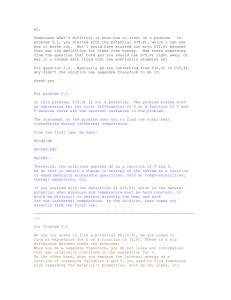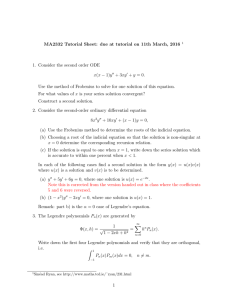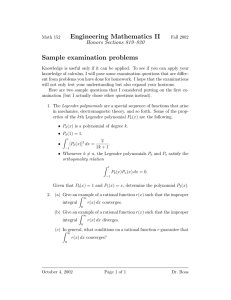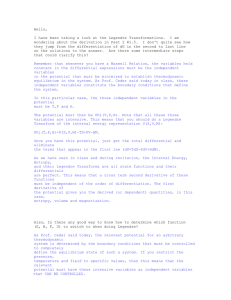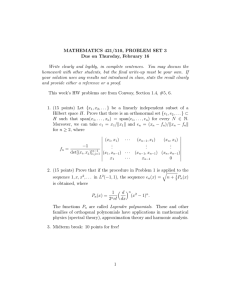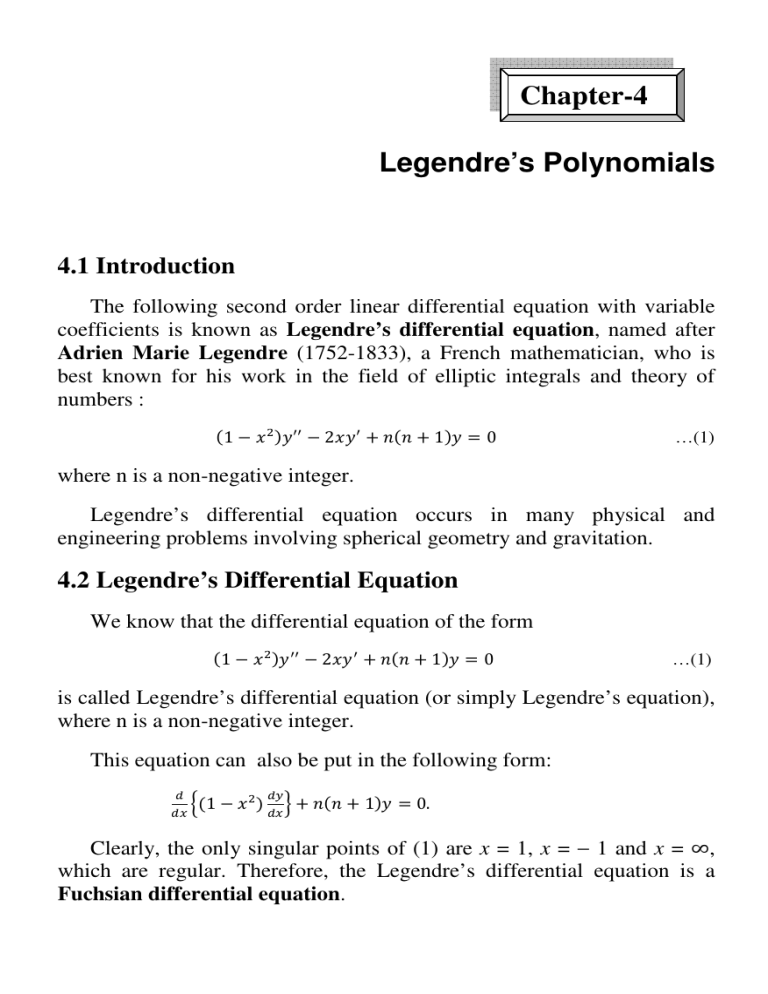
Chapter-4
Legendre’s Polynomials
4.1 Introduction
The following second order linear differential equation with variable
coefficients is known as Legendre’s differential equation, named after
Adrien Marie Legendre (1752-1833), a French mathematician, who is
best known for his work in the field of elliptic integrals and theory of
numbers :
1 2 1
0
…(1)
where n is a non-negative integer.
Legendre’s differential equation occurs in many physical and
engineering problems involving spherical geometry and gravitation.
4.2 Legendre’s Differential Equation
We know that the differential equation of the form
1 2 1
0
…(1)
is called Legendre’s differential equation (or simply Legendre’s equation),
where n is a non-negative integer.
This equation can also be put in the following form:
1 1
0.
Clearly, the only singular points of (1) are x = 1, x = − 1 and x = ∞,
which are regular. Therefore, the Legendre’s differential equation is a
Fuchsian differential equation.
92
The points other than singular points e.g., x = 0, x = 2, etc. behave like
ordinary points of (1).
Let the series solution of (1) be of the form
∑
, 0
∑∞
! 0 ! "
∑
"
"
and
!"
…(2)
!1
!"
…(3)
! 1 $
…(4)
Putting the above values of y, y and y" in (1), we have
∑∞
! 0 ! "
or
or
or
or
!"
∑
"
∑∞
! 0 ! "
∑∞
! 0 ! "
∑∞
! 0 ! "
! 1"
!2
2 ∑∞
!
2 ∑
"
!"
! 1 $
∑
&"
!"
! 1"
! $%
!"
!2
! 1"
∑
&"
! 1"
∑
"
!2
! 1"
! !
"
! "
! "
! !
!2
1 ∑
2"
!2
!
!"
! 1
∑
&"
!"
!"
0 ! "
"
0
1' 0
' 0
! ' 0
1 0
…(5)
which is an identity in x and, therefore, the coefficients of various powers
of x in it should be zero.
Thus, equating to zero, the coefficient of the smallest power of ,
namely $ in (5), we get the following indicial equation
0 "" 1
0
or
"" 1
0,
() 0 0*
93
which gives two indicial roots k = k1 = 1 and k = k2 = 0.
Note that the roots of indicial equation are unequal and differ by an
integer.
Now, to get the recurrence relation, we equate to zero, the coefficient
of $in (5). Thus, we have
! "
or
!"
!
! 1 !1 "
" !2 " !1
" !" !1
! 2 "
!2
!2
1
0
…(6)
Next, equating to zero, the coefficient of $% in (5), we obtain
1 "
1"
0
…(7)
For k = 0, we note from (7) that C1 is indeterminate.
Thus, putting k = 0 in (6), we get !
!2 !1
!!1
!2
…(8)
We now express C2, C4, C6…. in terms of C0 and C3, C5 C7…. in terms
of C1 by assuming that C1 is finite.
Putting m = 2 in (8), we have 2
1
2.1
0
2!
1
0
…(9)
Putting m = 4 in (8) and using (9), we obtain
4
2 3
4.3
2 2
4!
1
3
0
…(10)
and so on.
Next, putting m = 3 in (8), we obtain
3
1 2
3.2
1
1
3!
2
1
Again, putting m = 5 in (8) and using (11), we have
…(11)
94
3 4
5
5.4
3 1
3
2
5!
4
1
…(12)
and so on.
Now, the solution (2) can be re-written as:
or
% 0 0
/ /
2
0 0
% 1 1
/ /
2 , where k = 0
1 1
2
…(13)
Using the values of C2, C3, C4, C5,…... in the above equation, we get
31 44%
!
% 3 4$44$%4/
0!
4$%4
/!
0 2 5
4$/4$%440
/
1!
1
25
…(14)
which is the required general series solution, C0 and C1 being arbitrary
constants.
Solution of Legendre’s Differential Equation in
Descending Powers
4.3.
Consider Legendre’s differential equation of the type
1 2 1
0
…(1)
where n is a non-negative integer.
It is possible to obtain the solution of (1) in terms of descending
powers of x. Due to its applications to physical problems, this form of
solution of Legendre’s differential equation is more important.
For such a solution, let us assume that the Legendre’s differential
equation (1) has a series solution of the form
$
∑
, 0
…(2)
Then, by Frobenius method, we can find two linearly independent
solutions of (1) in descending powers of x as:
95
%
and
6 3 4 44$%
4$%
7 3 $4$%
4$
4%4
4/
44$%4$4$/
.04$%4$/
4$0 2 5
4%44/40
$4$/
.04/41
%./.1…4$%
$4$1
…(3)
25
…(4)
If we take 6
, the solution (3) is denoted by Pn (x) and is
4!
called Legendre’s function of the first kind or Legendre’s polynomial
of degree n [since (3) is a terminating series and so, it gives rise to a
4!
polynomial of degree n]. Again, if we take 7 %./.1…4%
, the solution (4) is
denoted by Qn(x) and is called Legendre’s function of the second kind.
Since n is positive, (4) is an infinite or non-terminating series and hence
Qn(x) is not a polynomial. Thus, Pn(x) and Qn(x) are two linearly
independent solutions of (1). Hence, the most general solution of (1) is
given by
9:4 ;<4 …(5)
where A and B are arbitrary constants.
Remarks: When there is no confusion regarding the variable x, we
shall use a shorter notation :4 for :4 , :4 for :4 and so on.
4.4 Legendre’s Functions of First and Second Kinds
Legendre’s function of the first kind or Legendre’s polynomial of
degree n is denoted by Pn(x) and is defined by
:4 %./.1…4$%
4!
3 4 44$%
4$%
4$
44$%4$4$/
.04$%4$/
We can also write :4 in a compact from as :
:4 (4 *
∑=
1=
⁄
,AB 4 AC FGFH
I
where [n/2] = 44$%
⁄,AB 4 AC DEE .
⁄
4$=!
?=!4$=!4$=
4$=
4$0 2 5
…(1)
…(2)
Legendre’s function of the second kind is denoted by Qn(x) and is
defined by
96
<4 4!
%./.1…4%
4%4
3 $4$%
4/
4%44/40
$4$/
.04/41
$4$1
2 5 …(3)
4.5 First Few Legendre’s Polynomials
Using the definition (1) or (2), the first few Legendre’s polynomials
are given by
: :0 1, :% %
J
, : 35 0 30 %
%
3 1, :/ %
3, :1 J
5 / 3
63 1 70 /
15, etc.
4.6. Generating Function for Legendre’s Polynomial Pn(x)
The function (1−2x h + h2)−1/2 is called as the generating function for
Pn(x) and, therefore, Pn(x) is the coefficient of hn in the expansion of
(1 – 2xh + h2)−1/2 in ascending powers of h, i.e., (1 – 2xh + h2)−½
4
∑
4 M :4 , || O 1 and |M| S 1.
Proof: Since |M| S 1 and || O 1 , therefore, we can write
(1 – 2xh + h2)- ½ = {1 – h (2x – h)}-1/2
1
%
%./
M2 M
.0
M 2 M
2
Coefficient of hn in R.H.S. of (1) is
%./…4$%
.0…4
%./…4$%
.0…4
%./…4$%
4!
%./…4$%
4!
:4 .
%./…4$/
. 24 24 3 4 3 4 3 4 .0…4$
4
4$%
4
4$%
44$%
4$%
4$
.0…4$
%./…4$/
.0…
1% 24$
1
. 1
%./…4$/
?TU
U
?TU
U
44$
.
4$%4$/
44$%4$4$/
.04$%4$/
M4 2 M4
2
…(1)
%./…4$1 4$
24$0
.0…4$0
4$%4$/
44$
M4$% 2 M4$%
.
4$4$/ ?TV
!
.
U
4$4$/ ?TV
!
4$0 2 5
.
U
25
25
2
97
Thus, we can say that in the expansion of (1 – 2xh + h2)−1/2, in ascending
powers of h, the Legendre’s polynomials P0(x), P1(x),P2(x),…. respectively
are the coefficients of h0, h1, h2,…. in the expansion given by (1).
Hence, we have
1 2M
4
∑
4 M :4 , where : M $%/
1.
This shows that Pn(x) is the coefficient of hn in the expansion of
1 2M M $%/ . This is why 1 2M M $%/ is called as the generating
function of the Legendre’s polynomial Pn(x).
4.7 Murphy’s Formula for Legendre’s Polynomial Pn(x)
Consider the Legendre’s differential equation
1 2 2
1
0
…(1)
where n is a non-negative integer.
It has only three singular points namely x = 1, x = −1 and x = ∞ and
all are regular. Therefore, Legendre ‘s differential equation is a Fuchsian
differential equation with three regular singular points x = 1 , x = −1 and
x=∞.
Let us find the solution of (1) about the singular point x = 1 as follows:
%
The substitution t = 1 transfers the singular point x = 1 to t = 0.
In this case, the Legendre’s differential equation (1) is transformed to
the following differential equation:
X1 X 1
2X 1
0
…(2)
This transformed differential equation is in the hypergeometric form
with a = − n , b = n + 1 and c = 1.
All solutions of the transformed differential equation (2) are
represented by the P- symbol as follows:
98
0 1
: Y0 0
0 0
∞
1
XZ
…(3)
Hence, all solutions of the Legendre’s differential equation (1) are
represented by the following P- symbol :
0 1 ∞
: Y0 0
1 Z
0 0 …(4)
One of the solutions of the differential equation (2) is the polynomial
F(− n; n + 1; 1;t).
Now, replacing X 7 1 ⁄2, we can have one of the solutions of
Legendre’s differential equation (1) as:
: [ \ ,
1; 1;
1
2
^
…(5)
which is the polynomial solution of (1). This relation (5) for Pn(x) is
known as the Murphy’s formula for Legendre’s polynomial Pn(x).
4.8. Laplace’s Definite Integrals for Pn(x)
(I) Laplace’s First Integral for Pn(x): When n is a positive integer ,
then Laplace’s first integral for Pn(x) is given by
:4 % _
` (
_ a b 1 cos f*4 gf
…(1)
Proof: From integral calculus, we have
_
`
h
iaj kDC h
_
biU $j U
, where 6 l 7 .
…(A)
Putting a = 1 – hx and b = h b 1 so that a2 – b2 = (1− hx)2 – h2
(x – 1) = 1 – 2hx + h2.
2
Using these values of a, b and a2 – b2 in (A), we have
99
m1 2M
_
M $%/
` (1 M a Mb 1 cos f*$% gf
_
` (1 M& n b 1 cos f'$% gf
_
` (1 MX*$% gf, where X
_
4
m ∑
4 M :4 or
` 1 MX
M X _
2
4
` (∑
4MX *gf
n b 1 cos f
M4 X 4
_
2 gf
4
4
∑
4(M ` X gf*.
Equating the coefficients of hn on both sides, we have
_
m :4 or
_
` X 4 gf
` ( a b 1 cos f*4 gf
:4 % _
` (
_ :4 % _
h
.
`
_ (ab U $% kDC h*?rs
a b 1 cos f*4 gf.
(II) Laplace’s Second Integral for op q: When n is a positive
integer, then Laplace’s second integral for :4 is given by
…(2)
Proof: From integral calculus, we have
_
`
h
iaj kDC h
_
biU $j U
, where 6 l 7 .
…(A)
Putting a = hx – 1 and b = h b 1 so that a2 – b2 = 1 – 2hx + h2.
Using these values of a, b and a2 – b2 in (A), we have
m1 2M
or
or
_
t
%
31 2 _
t
t
∑
4
_
_
M $%/
` (1 M a Mb 1 cos f*$% gf
% $%/
tU
%
: t? 4
_ %
%
` 3tu
_
5
`
tu
%
` (M& a b 1 cos f' 1*$% gf
_
` MX 1$% gf, where X
% $%
31 5
tU u U
tu
%
tv u v
gf
2
_ %
`
%
tu
31
t?rs u ?rs
%
tu
a b 1 cos f
%
ts u U
2 5 gf
2
%
t? u ?
2 5 gf
_ %
%
gf5
`
t?rs u ?.s
∑
4 3
100
∑
4 w
_
%
h
x
`
t?rs ab U $% kDC h?rs
%
Now, equating the coefficient of t?rs
from both sides, we have
_
m :4 `
?rs
% _
h
`
_ ab U $% kDC h?rs
:4 h
ab U $% kDC h
Remarks: Replacing n by – (n + 1) in Laplace’s second integral, we
have
% _
` &
_ :$4% :4 ,
a b 1 cos f'4 gf
[From Laplace’s first integral.]
Hence, we have
o$py q op q , which can also be obtained by
using the Murphy’s formula for Pn(x).
4.9. Orthogonal Properties of Legendre’s Polynomials
y
(I) `$y
oz q op q{q
y
(II) `$y
(op q* {q
| }~ z p.
py
.
Proof: (I) Legendre’s differential equation may be written as
1
1
0
…(1)
Since :4 is a solution of Legendre’s differential equation (1),
therefore, we have
1
?
1:4
0.
…(2)
Similarly, if we consider the Legendre’s differential equation
Then, we have
1
1
!!
!!
1
0
…(3)
1:
0.
…(4)
101
Multiplying (2) by : and (4) by :4 and then subtracting, we have
:
1 ?
:4
1
& 1 !!
1':4 :
0
Integrating the above between the limits – 1 to 1, we have
$%
`$% 3: 1 ?
$%
5 g `$% 3:4
1 &
5 g
1 !!
%
1' `$% : :4 g
0
On integrating by parts, we obtain
3: 1 ? %
5
$%
% ?
`$%
or
& Hence, we have
% ?
`$%
1 1 !!
%
1 ?
( g
%
g 3:4 1 1' `$% : :4 g
`$% : :4 g
1 !!
0
%
5
$%
%
1* `$% : :4 g
0.
0, if ! (II) We know that the generating function for :4 is given by
1 2M
Also, we have
1 2M
M $%/
M $%/
4
∑
4 M :4 …(3)
∑
4 M : …(4)
Multiplying the corresponding sides of (3) and (4), we get
1 2M
M $%
4
∑
: :4 .
∑4 M
Integrating the above between the limits – 1 to + 1, we have
%
`$% 1 2M
or
%
4 (:
∑
4 *
4 `$% M
M $% g
%
4
∑
`$% : :4 5
∑4 3M
%
4
∑
: :4 g
,4 `$% M
4
%
Now, since `$%
: :4 g
%
`$%
%$ttU 0, where ! . Therefore, we have
102
%
4 (:
∑
4 * g
4 `$% M
%
`$%
%
t
%$ttU %
t
(log1 2M
&log1 M log1
%
(log1 M log1 M *
%
3\M 3M
t
t
t
tU
tv
/
tv
t
/
M ' ,
2 ^ \M 25
1
t
M *%
$%
∑
4
tU
tU?rs
tv
/
4%
2 ^5
∑
4
tU?
4%
Now, equating the coefficients of M4 from both sides, we have
%
`$% (:4 * g
4%
Remarks: Making use of the Kronecker delta, the results (I) and (II)
can be written in compact from as
%
`$% : :4 g
4% 4
%,AB 4. I
,AB 4
where Kronecker delta 4 is defined by 4
4.10 Recurrence Formulae for Legendre’s Polynomials
(I) p
yq op q
p
yopy q
pop$y q.
Proof : Generating function for :4 is given by
1 2M
M $%/
4
∑
4 M :4 …(1)
Differentiating both sides of (1) w.r.to h, we have
%
1 2M
M $// 2
Multiplying both sides by( 1 2M
M1 2M
or
M $%/
4
M ∑
4 M :4 M )
2M
and simplifying, we have
1 2M
1 2M
4$%
∑
:4 4 M
4$%
M ∑
:4 4 M
4$%
M ∑
:4 , on using (1)
4 M
103
or
4
4%
∑
:4 4 M :4 ∑4 M
4$%
4
∑
:4 2 ∑
4 M
4 M :4 4%
∑
:4 4 M
…(2)
Equating the general coefficients of M4 on both sides of (2), we have
:4 :4$% 1:4 2
or
1:4% 2 :4 1:4% 1:4$% :4$% .
This recurrence relation is the classical three-term relation for Pn(x)
and it is a pure recurrence relation for Legendre’s polynomials.
Remarks: Equating the general coefficients of M4$% on both sides of
(2), we get
:4$% :4$ or
pop q
:4 2 1:4$% 2:4$ p yqop$y q p yop$ q.
This is a substitute recurrence relation of (I) and may be directly
obtained by replacing n by (n – 1) in (I).
(II) pop q
qo p q o p$y q,
Proof: Generating function for :4 is given by
1 2M
M $%/
4
∑
4 M :4 …(1)
Differentiating (1) w.r.to h, we have
M1 2M
M $//
4$%
∑
:4 4 M
…(2)
Again, differentiating (1) w.r.to x, we have
M1 2M
M $//
4
∑
4 M : 4 …(3)
Multiplying both sides of (3) by (x – h), we have
or
M M1 2M
M $//
4
M ∑
4 M : 4 Now, from (2) and (4), we have
M ∑∞ 0 M
1
: M ∑∞ 0 M : …(4)
104
4
∑
4 M :4 or
4
4%
∑
: 4 4 M : 4 ∑4 M
…(5)
Equating the general coefficients of M4 on both sides of (5), we have
:4 : 4 : 4$% This recurrence relation is a differential recurrence relation.
(III) p
yop o py q o p$y q.
Proof: From recurrence formula (I), we have
2
1:4 1:4% :4$% .
…(1)
Differentiating both sides of (1) w.r.t. x, we have
2
1: 4 2
1:4 1: 4% : 4$% ,
…(2)
From recurrence formula (II) we have
: 4 :4 : 4$% …(3)
Eliminating : 4 from (2) and (3), we have
2
or
or
2
1( :4 1
2
: 4$% *
1:4 1
p
(IV) p yop q
2
1:4 1: 4% 1:4 yop q
1: 4% : 4$% 2
1: 4% o py q o p$y q
: 4$% 1: 4$% 1: 4$% .
o py q qo p q
Proof: Writing recurrence formulae (II) and (III), we have
and
2
:4 1:4 : 4 : 4$% : 4% : 4$% Subtracting (1) from (2), we have
p
(V) y q o p q
yop q
o py q qop q
p(o p$y q qo p q*.
…(1)
…(2)
105
Proof: Replacing n by (n – 1) is recurrence formula (IV), we have
:4$% : 4 : 4$% .
:4 Writing recurrence formula (II), we have
…(1)
: 4 : 4$% …(2)
Multiplying (2) by x and then subtracting from (1), we have
&:4$% :4 '
y q o p q
or
(VI) y q o p q
p
1 : 4 po p$y q qo p q.
y(qop q opy q*.
Proof: Writing recurrence formula (I), we have
2
1:4 1:4% :4$% …(1)
which may also be written as
or
1:4 :4 1:4% :4$% (:4$% :4 *.
1(:4 :4% *
Writing recurrence formula (V), we have
(:4$% :4 *.
1 : 4 …(2)
Now, from (1) and (2), we have
y q o p q
p
y(qop q opy q*.
…(3)
4.11 Beltrami’s Result
The following relation is known as Beltrami’s Result:
2
1 1: 4 1(:4% :4$% *.
Proof : From recurrence formulae (V) and (VI), we have
1 : 4 and
1 : 4 (:4$% :4 *
1(:4 :4% *
Multiplying (1) by (n +1) and (2) by n and then adding, we get
…(1)
…(2)
106
(
or
1
2
*1 : 4 1(:4$% :4% *
1 1: 4 1(:4% :4$% *.
4.12 Christoffel’s Expansion
The following relation is known as Christoffel’s Expansion:
2 1:4$% 2 5:4$% 2 9:4$% 2, the last
term of the series being 3P1(x) or P0(x) according as n is even or odd.
: 4 Proof: From recurrence formula (III), we have
: 4% 2
1:4 Replacing n by (n – 1), we have : 4 : 4$% …(A)
2 1:4$% : 4$ …(1)
Replacing n by (n – 2), (n – 4),….4,2 in (1), we have
: 4$ : 4$0 2 5:4$/ 2 9:4$1 : 4$0 …(2)
: 4$ …(3)
… …. …. …. …. …. ….
: 3:% : 3:% () : 0*
Adding (1),(2),(3), ……, we have (when n is even):
: 4 2 1:4$% 2 5:4$/ 2 9:4$1 2
3:% 1
: *
Again, when n is odd, the last of the above relation is
: / 5: :% 5: : .
() :% Adding as before, we have (when n is odd):
: 4 Hence
: 4 2 1:4$% 2 1:4$% 2 5:4$/ 2 5:4$/ 2
5: : .
2 9:4$1 2
The last term of the series being 3P1(x) or P0(x) according as n is even
or odd.
107
4.13 Christoffel’s Summation Formula
The following formula is known as Christoffel’s Summation
Formula:
∑4=2
1 := := 1 3
?rs ?$?rs ?
5
$
Proof: From recurrence formula (I), we have
2
2
and
1:
1:
1:
1:
1
1
:1 …(1)
:1 …(2)
Multiplying (1) by := and (2) by := and then subtracting, we have
2
1 : :
1(:
1
: : 1 : *
(:=$% := :=$% := *
…(3)
Now, putting r = 0 in (3), we have
: : :% : :% : () : 1
…(A0)
: 6 g :% :% *
Again, putting r = 1, 2, 3,….., (n – 1), n in (3), we have
3 :1 :1 5 :2 :2 2(:2 :1 :2 :1 *
(: :% : :% *
3(:3 :2 :3 :2 *
2(:% : :% : *
….
….
…..
…..
….
…. ….
…… …..
….
….
…..
…..
….
…. ….
…… …..
2 1 :4$% :4$% …(A1)
. (:4 . :4$% :4 :4$% *
1(:4$ :4$% :4$ :4$% *
2 1 ::
…(A1)
1(:4% : :4% : *
…(An -1)
108
:4$% :4 :4$% :4
…(An)
Adding (A0), (A1), (A2),….(An-1) and (An) together, we have
∑4=2
1 := := ∑4=2
or
1 := := 1(:4% :4 :4% :4 *
?rs ?$?rs ?
1 3
5
$
4.14. Rodrigue’s Formula for Pn(x)
The following is known as the Rodrigue’s formula for Pn(x):
{p
y
op q
q yp
.
p!p {qp
14 .
Proof: Let us take
Differentiating it w.r.t x, we have …(1)
2 14$%
Multiplying both sides by 1 and using (1), we have
1 2 …(2)
Differentiating it (2), (n + 1) times by Lebnitz’s theorem, we have
1
or
or
?rU ?rU
1
1 ?
Putting ?
1
?rU ?rU
?rU ?rU
?rs ?rs
2
2
. 2
?rs ?rs
?rs 4%4 ? ?rs
!
?
1
1
.2
2 3.
? 0
?
? ?rs ?rs
0.
?
1
?
?
. 15
…(3)
in (3), it becomes
1 U
U
2
1
0
…(4)
which is the Legendre’s differential equation whose solution is given by z
= C Pn(x), where C is a constant.
? ?
:4 Putting x = 1 in (4), and then using Pn(1) = 1, we get
…(5)
109
\
? ^
? %
, since Pn(1) = 1.
…(6)
Now, from (1), we have
1 4
14 . 14
…(7)
Differentiating (7) w.r.t. x, n times by Leibnitz’s theorem, we have
?
14 .
?
4!
14 !
%!
?
?
14
.
14 1 14
?
Putting x = 1 in it, we have \?^
Using (6) in it, we find
?Ts
?Ts
2
?Ts
?Ts
14
. 1
%
24 . !
14 . 14$%
14 . !
4!
%!
14$%
14
1
2
?
?
14
14 . !
…(8)
Therefore, by putting the value of C from (8) in (5), we get
%
:4 .
?
4!?. ?
14 .
…(9)
which is the required Rodrigue’s formula for Pn(x).
Illustrative Examples
Example 1. Using generating function for Pn(x), prove the following:
: 1, :% :0 and
, : s
s
U
3 1, :/ 35 0 30 s
v
3.
5 / 3
Solution: Generating function for Pn(x) is given by
4
∑
4 M :4 1
or
: t
2 M
M:% 1
1 2M
%./
.0
s
U
%./.1
M 2 M
M : . M
M $%/
M/ :/ %
.0.
(1 M2 M*$%/
M/ 2 M
M0 :0 3 1M 5 / 3M/
2
s
%./.1.
.0..J
35 M0 2 M0
2
30
2
3M0
110
Equating the coefficients of like powers of h on both sides, we have
: : :/ :0 1, :% %
%
%
J
,
3 1
5 / 3
35 0
30 3
Example 2. Express f(x) = x4 + 2x3 + 2x2 – x – 3 in terms of Legendre’s
polynomials.
Solution: We know that
: : :/ :0 1, :% s
U
s
U
%
J
,
…(1)
3 1
…(2)
5 / 3
35 0
v
Next, from (2), we have U
v Also, from (1), we have 30 :0 Now, from (4), we have 0
Again, from (3), we have /
…(3)
U
v
: s
.
v
:% , 1
…(4)
vv .
:/ 3
.
: .
Substituting in succession the values of x4, x3,….in the given
polynomial, we have
v
:0
v
:0
v
v
:0 :0 vv
2 /
2 /
s
v
U
2 3 :/ V
1
:/ 2 3
/
1
5
: U U
v s
v
U
s
v
s
%J
/1
111
v
v
:0 V
:0 V
:/ : V
Vs :/ s
: V
Vs s
UUV
s
:% UUV
: .
s 0 , if gg
I
Y $4?/U4!
? &4/!'U , if
Example 3. Prove that :4 0
Solution: We know that the generating function for Pn(x) is
4
∑
4 M :4 1 2M
M $%/
…(1)
Putting x = 0 in both sides of (1), we have
4
∑
4 M :4 0
1
%
M %./
.0
M $%/
1
%./.1
M .0.
&1 M '$%/
M /
2
%./.1…=$%
.0…=
M =
2
…(2)
We observe that all the powers of h in R.H.S. of (2) are even.
Therefore, equating the coefficients of hn from both sides of (2), we
have
:4 0
0, if n is odd.
…(3)
Again, equating the coefficients of h2m from both sides of (2), we have
%./.1…$%
: 0
.0.….
1
1
!
U!U
…(4)
Putting 2m = n in above, we have
$%?/U 4!
:4 0
?&4/!'U
…(5)
Example 4. Prove that 1 2
U
Solution. Let
U
1 1 2
Then, we have
U
U
$%/
$%/
U
U
is a solution of the equation
0
4
∑
4 :4 , where :4
4
∑
4 :4
4%
(∑
:4 *
4
4%
∑
:4
4
∑
4
:4 1 4% :4
112
or
U
U
∑
4
Also, we have
1
1 4 :4
4
∑
4 :4 ,
4
&1 ∑
4 : 4 '
4 4
1 ∑
4 : 4 2 ∑4 : 4
Substituting the values from (1) and (2) in the L.H.S. of the given
equation, we have
U
U
1
∑
4( 1 4 : 4 2 4 : 4
1 4 :4
4
∑
4 (1 :
4
2: 4
1:4 *
4
∑
4 . 0 [since Pn is a solution of Legendre’s equation]
= 0.
Example 5. Prove that |Pn(x)|O 1, when – 1 O x O 1.
Solution: From Laplace’s first integral for Pn(x), we have
%
:4 4
_
` 3 a b1 cos f5 gf
_ If – 1 O x O 1, then putting :4 cos
|:4 |
% _
` cos
_ |:4 cos |
%
_
%
cos in (1), we get
a sin cos f4 gf.
_
%
_
` cos a sin cos f4 gf
_
` cos a sin cos f4 gf
_
O ` |cos a sin cos f4 | gf
_
%
_
%
_
4
` bcos a sin cos f gf
_ O ` bcos
_
%
_
O ` bcos
_
4
sin cos f gf
4
sin gf , since f O 1
…(1)
113
% _
` gf
_ %
_
%
(f*_
_
.m
1.
Hence, we have |Pn(x)| O 1, when – 1 O x O 1.
Example 6. Prove Pn(x) = P-(n+1)(x) by using Murphy’s Formula for Pn(x).
Solution: Murphy’s formula for Pn(x) is given by
: [ \ ,
1; 1;
1
2
^
…(1)
From symmetric property of hypergeometric function, we have
[ \ ;
%$
1; 1;
^
[\
1; ; 1;
%$
^
:$4% …(2)
Thus, from (5) and (6), we get
: :
1 …(3)
EXERCISE 4
Using Rodrigue’s formula for Pn(x), prove the following:
1.
: and
1, :% , : :0 s
s
U
3 1, :/ 35 0 30 3 .
s
U
5 / 3
2.
Show that Pn(1) = (1).
3.
(i) Show that Pn (− x) = (− 1)n Pn(x). Hence, deduce that Pn (− 1) = (− 1)n.
(ii) Prove that Pn(x) is an even or odd function of x according as n is even or odd
respectively.
4.
5.
Prove that : 4 : 4$ Prove that : ¡ : J 6.
Show that 11 1: 1 7.
Prove that
8.
Show that %$ Uv/U
9.
Prove that
%
%$ U s/U
%$ U %
2 1:4$% 9:¡ .
30(: :0 *.
∑
4(:4 ∑
42
:4% * 4 .
1 :4 4 .
114
?rs $?Ts (i) ` :4 g
10. Show that
4%
%
`$% :4 :4$% g
%
4
04U $%
%
0,
%
?Ts $?rs 4%
.
44%
11. Prove that `$% 1 (: 4 * g
12. Prove that (i) `$% :4 g
%
(ii) ` :4 g
and
4%
%
(ii) `$% : g
0 and
%
.
2.
%
13. Evaluate (i) `$% / :0 g (ii) `$% ¡¡ :% g and (iii) `$% : g .
14. If Pn(x) is defined by the relation 1 2M
that 1 :
%
4 2: 4 15. Prove that `$% (: 4 * g
M $%/
1:4 1.
0
4
∑
4 M :4 , then, show
16. Express x8 as series in Legendre’s polynomials of various degrees.
17. Express the following in terms of Legendre’s polynomials:
(i) 5 18. Prove that
(i) 19. If
6
: (ii) 5 /
and
: ,
s
U 1
(ii) /
U
v 0, 1 S S 0I
then show that
, 0 S S 1,
20. Prove that 0
: s
V s
v
(8:0 : s
U %
:% v
: vU
:0 s 20: v
7: *.
: .
U
v /
2
21. Solve the Legendre’s differential equation 1 2 1
0
about its ordinary point x = 0 by assuming a solution of the form y = ∑
and
show that the general solution of it is given by 6£ 7, where
£
and
22.
(i)
(ii)
(iii)
(iv)
1
44%
!
4$%4
/!
44$4%4/
/
0!
0 2
4$%4$/440
1!
1 2
Prove that :
2
1 :4 1:4% :4$% .
:4 : 4 : 4$% 2
1:4 : 4% : 4$% 1:4 : 4% : 4 115
23.
(i)
(ii)
24.
Prove that
(: 4$% : 4 *
1 : 4 1 : 4 1(:4 :4% *
Prove that
2
1(:4% :4$% *..
1 1: 4 ANSWERS
13.(i) 0
16.
(ii) 0
%J
: 0/1 J
0
: 0¡1
17. (i) :/ 1
(iii) 4/15
%
/1
: /
0J
: %0/ 0
1
0
: ¡¡ :% : ,
/
%
: ¡ (ii) 2:/ 4:% .
OBJECTIVE TYPE QUESTIONS
Choose the correct alternative in the following questions:
1. Legendre’s differential equation is :
(A) 1 2 (B) 1 1
0
1
0
(D) 1 2 1
0.
2 (C) 1 2 1
0
2. The value of Pn (1) is :
(A) 0
(B) 1
(C) n
(D)
%
4
3. Rodrigue’s formula for Pn (x) is :
(A) :4 (C) :4 %
?
?¤4I ?
% ?
? ?
14
14
(B) :4 (D) :4 %
?
? ¤4I ?
% ?
? ?
14
14 .
116
%
4. The value of `$% :4 dx when n 0 is :
(A) 0
(B) 2
(C) 1
(D) – 1.
%
5. The value of `$% :4 dx is :
(A) 1
(B) 0
(C) x
(D) 2n.
6. Let % £, / , / 1
and on the interval ( - 2, 2), then
(A) A = 0, B = 1
(C) A = 0, B = 9
; . If / is orthogonal to % (B) A = 0, B = 0
/
0
(D) None of these
7. The value of Pn (−1) is :
(A) 1
(B) 0
(C) – 1
(D) (−1)n
8. The following differential equation is known as:
1 2 1
0
(A) Hermite’s equation
(B) Legendre’s equation
(C) Chebyshev equation
(D) Bessel’s equation
9. All roots of Pn(x) = 0 are :
(A) Real
(B) Some real and some complex
(C) 0
(D) Complex
10. If Pn(x) is Legendre’s polynomial, then
(A) :4 (C) :4 1
:4 1
(B) :4 14 :4 (D) None of these
117
11. Two real function f1(x) and f2(x) are said to be orthogonal functions on interval
6 O O 7, if
j
j
(A) `i % g S 0
j
(C) `i % g
0
12. 1 : 4 :4$% (A) :4 (B) `i % g l 0
(D) None of these
2
(C) :4 0
(B) 2:4 (D) :4 13. The value of P0 (x) is :
(B) ∞
(A) 0
(C) 1
(D) None of these
14. ` :4 g
%
(A)
?rs
(C)
4
%
2
&:4% :4$% '
&:4% :4$% '
15. The value of
%
?
?4! ?
1 is :
(B) :4% :4$% (D) :4% :4$% .
(A) 0
(B) 1
(C) :4 (D) None of these
%
16. The value of `$% ¡¡ :% g is
(A) 1
(B) − 1
(C) 0
(D) None of these
17. :4 (A) :4 (C) <4 14 ….
(B) :$4 (D) <$4 118
18. :4% 0
2
(A) 0
(B) 1
(C) n
(D) 2n + 1
19. :4 1
2
(A) 0
(B) 1
(C) − 1
(D) 14
20. All roots of :4 (A) 1 and +1
(C) 0 and n
0 lie between
(B) 0 and 1
(D) – n and n
ANSWERS
1. (A) 2. (B) 3. (A) 4. (A) 5. (B) 6. (C) 7. (D) 8. (B) 9. (A) 10.(B)
11.(C) 12. (D) 13.(C) 14. (A) 15. (C) 16. (C) 17. (A) 18. (A) 19. (D) 20.(A)
